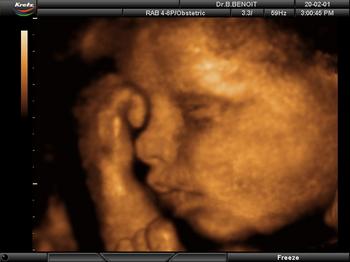 One rarely gets to see a religion ghost hiding in the details of a newspaper's all-powerful manual of language, style and grammar. But there one was, drifting between the lines of a New York Times article on the hot new shops that, for a few hundred dollars, allow a woman to buy sepia-toned ultrasound digital prints of her unborn child to give to family members and friends -- by hand or email.
Hidden in that last sentence is the ghost -- the words "unborn child." Most newspapers follow stylebooks that call for the use of the more clinical, neutral word "fetus." The assumption, of course, is that this highly organized mass of tissue is not an "unborn child" or "baby" unless the mother, for religious reasons, chooses to say that it is.
One rarely gets to see a religion ghost hiding in the details of a newspaper's all-powerful manual of language, style and grammar. But there one was, drifting between the lines of a New York Times article on the hot new shops that, for a few hundred dollars, allow a woman to buy sepia-toned ultrasound digital prints of her unborn child to give to family members and friends -- by hand or email.
Hidden in that last sentence is the ghost -- the words "unborn child." Most newspapers follow stylebooks that call for the use of the more clinical, neutral word "fetus." The assumption, of course, is that this highly organized mass of tissue is not an "unborn child" or "baby" unless the mother, for religious reasons, chooses to say that it is.
Which brings us to a winsome New York Times feature by Marc Santora that opens with a mother-to-be, Limor Fronimos, visiting an establishment called A Peek in the Pod. (Tip of the hat to Catholic uberblogger Amy Welborn for noticing this.) Near the end of the story, sonographer Narda Johnson is working to get the right pose:
When the baby would not cooperate, choosing instead to shield herself with tiny hands from the prenatal equivalent of paparazzi, Ms. Johnson turned to a trick she picked up during the 20 years she has performed ultrasounds in doctors' offices.
She gave the mother chocolate.
"It goes straight to the baby," Ms. Johnson said. "It's a sugar rush."
Sure enough, the image on the screen soon became clearer, and a big smile could be discerned.
And there you have it. The URL at the Times includes a "17fetus.html" reference, but by this point in the story it was impossible to use any term other than "baby." Read the whole article and try to edit in the term "fetus" for the word "baby" in all of the paragraphs that are not direct quotations. It just doesn't work.
Which is why it was a tense moment in the abortion media wars when General Electric began trying to advertise this remarkably clear 4D ultrasound imaging system. Were these ads anti-abortion hate speech? After all, religious conservatives -- take columnist Cal Thomas, for example -- were going to write all kinds of things, like this:
The clarity of the image resembles a high quality photograph. Everyone who sees such a picture will find it extremely difficult to regard the image as anything but that of a baby; not a "fetus," not a "product of conception," not disembodied tissue. The hands move. So does the head. Does the baby's status change because the parents love him or her and want their child to be delivered safely so they can hold in their arms what the mother now holds in her womb? Or does the child inherit an intrinsic right to life separate from what politicians, lawyers, judges and even the woman herself might think?
Words matter and, in Oprah America, photographs matter even more.
It will be interesting to see how other newspapers cope with this issue. Is this another case where the New York Times will set the new standard?
